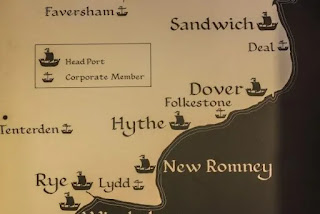When Edward the Confessor died on 5 January 1066, he supposedly made a deathbed statement committing his kingdom into the care of Harold Godwinson, his wife's brother. As the most powerful man in England after the king, he was a natural choice. Whether Edward actually made that statement or not, the witenagemot, the group of wise men who counseled the king, approved Harold as king. He was crowned on the same day Edward was buried. (Some say he crowned himself, as in the illustration.)
When word reached Duke William of Normandy across the English Channel, the response was understandably extreme: William claimed that Edward had named him his heir years earlier. If that happened, perhaps William visited Edward when Edward had exiled the Godwins (and would not have considered a Godwin as his heir), but if so it might not have been that serious an offer. Edward and William were first cousins—William's grandfather was Richard II of Normandy, brother of Emma of Normandy, Edward's mother—and so there was an argument for William being in the line of succession.
Supposedly Harold himself had sworn on a saint's relics two years earlier to recognize William as king of England after Edward, after William saved Harold from capture by Guy of Ponthieu.
William was incensed. The report that Harold had broken a vow made on holy relics was so significant that it enabled William to procure the pope's blessing to depose Harold and take the throne. (Of course, William might have had help: Pope Alexander II was a former student of Lanfranc, who had been first an enemy and then a supporter of William and was not above exercising his influence on his former pupils.) The fact that William's army marched under a papal banner and blessing would have had a demoralizing effect on Harold's forces.
Worse than the psychological effect, however, would have been physical exhaustion. The stories we hear in our grade-school history books about 1066 leave out a third party: Harald Hardrada.
Harald Hardrada, King of Denmark and Norway, also believed he had a claim to England, since Danes had ruled it in times past. Harald landed in the north of England in September of 1066 with 300 longships, 15,000 men, and King Harold's brother, Tostig. On September 20 he defeated the first English forces he encountered. King Harold, however, met Harald five days later at the Battle of Stamford Bridge. Once Harold's forces managed to cross the bridge, he killed Harald and Tostig and defeated the army so soundly that only 24 ships survived to flee back to Denmark. This was not an easy battle, however, and the standoff at Stamford Bridge alone supposedly cost Harold about 20 of his best warriors and closest companions. See more here and here.
...and while Harold's army was recovering from their hard-won battle, the message arrived that William's fleet had arrived at Hastings, 300 miles away. The army (not recovered from their battle) had to march quickly south and meet William's fresh forces who had had plenty of time to prepare their defenses and pick the battle site. Who knows what would have happened if Harold's forces had been able to meet William's while at full strength? The years following the Battle of Hastings in 1066 are well-known, but history books too often leave out the crucial three weeks prior to the battle, when Harold and his English army performed herculean tasks to defend their shores.
If Edward died 5 January and Hastings took place in October, what was William doing for ten months? I'll tell you next time.



















